It looks like you're using an Ad Blocker.
Please white-list or disable AboveTopSecret.com in your ad-blocking tool.
Thank you.
Some features of ATS will be disabled while you continue to use an ad-blocker.
3
share:
When I was younger, I learned to use several pieces of heavy equipment, from front-end loaders, to track mobiles, to fork lifts.
It's a pretty good feeling to master the operation of a massive machine or in the case of the track mobile, a small piece of equipment capable of hauling a string of train cars. What most pieces of heavy equipment have in common is hydraulic power. It takes a while to really get the feel of smoothly operating hydraulics, but once learned, that skill generalizes to almost any piece of equipment.
I went up to northern New Mexico with a friend recently to help him get a load of lumber and I was mightily impressed with the skill of this logging company owner using the grappler, which is part of his logging truck, which is a massive piece of equipment.
Here is a little two minute video demonstrating his expertise and finesse with this remarkable machine.
If you have a favorite piece of machinery that you admire, operate, or have operated in the past, why not post your thoughts here, as well as some pictures, whether they are original or not.
[edit on 2008/8/18 by GradyPhilpott]
It's a pretty good feeling to master the operation of a massive machine or in the case of the track mobile, a small piece of equipment capable of hauling a string of train cars. What most pieces of heavy equipment have in common is hydraulic power. It takes a while to really get the feel of smoothly operating hydraulics, but once learned, that skill generalizes to almost any piece of equipment.
I went up to northern New Mexico with a friend recently to help him get a load of lumber and I was mightily impressed with the skill of this logging company owner using the grappler, which is part of his logging truck, which is a massive piece of equipment.
Here is a little two minute video demonstrating his expertise and finesse with this remarkable machine.
If you have a favorite piece of machinery that you admire, operate, or have operated in the past, why not post your thoughts here, as well as some pictures, whether they are original or not.
[edit on 2008/8/18 by GradyPhilpott]
reply to post by GradyPhilpott
I am a disaster operating heavy machines.. But I can appreciate true talent..
This guy is amazing....
He seems almost "gentle" in the way he places the logs...
Semper
I am a disaster operating heavy machines.. But I can appreciate true talent..
This guy is amazing....
He seems almost "gentle" in the way he places the logs...
Semper
Gentle is a good description even though of course those claws probably weigh several hounded pounds without the arm that swings them around, but as
anyone can see, he does place them "gingerly" and he needs no one to straighten them by hand once he has them in place.
Well, I did a little research last night before I finally got so sleepy I couldn't stay up any longer.
As I said, my heavy equipment days are long behind me, but I did find pictures on the internet of machines that are very close to the ones I operated as a potash mine loading dock operator in Carlsbad, New Mexico in the mid-seventies.
Caterpillar 950
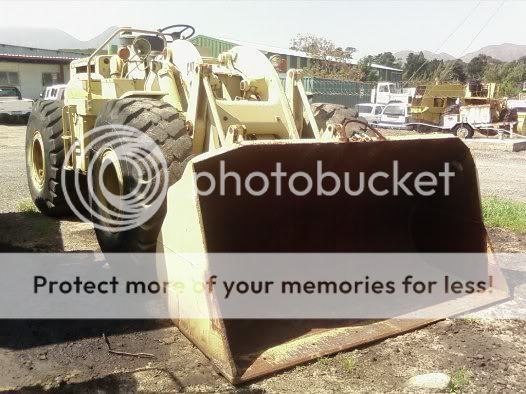
The oldest of the Cats was like this, completely open and by the time I went work there, it was as loose as a goose, but still fun to operate. Depending on the warehouse we worked in with these, the pace was slow and the space cramped with the hopper openings about ten feet above the ground to much larger warehouses where, even if the place was so full it was cramped, you could with some diligent work clear enough space to make the job as fun as anything you can imagine.
In the larger warehouses, the hoppers were buried in the floor, so that you could just push the potash into the hopper when the warehouse was full or race like hell to carry the potash in your four-ton capacity bucket to the hopper where the belt was running at six tons a minute.
It was under the latter conditions that was the most fun. The Cat 950 was in those days the Formula One equivalent of front-end loaders. They were powerful and fast, with a gear shift and direction lever on the left-hand side of the steering wheel. To go forward you pushed the lever forward and shifted through the four gears by twisting the lever. To go backward, you pulled the lever back and twisted the lever to go through four gears. Four reverse gears can make things pretty exciting at times.
The only way you could get a break was to build a pile on the hopper grate high enough to let you go smoke a cigarette or go to the head. It was during this time that I began to dip.
In the warehouses with raised hoppers, you were pretty much stuck, because once the hopper was full there was no more adding to it and they would empty pretty fast, so the pace was slow and steady, which could make for a pretty mind-numbing shift.
The Cats were also articulated which meant that they bent in the middle, which made them highly maneuverable. Whichever warehouse you were working in, you better hope you were working with one of the Cat 950's, because if you had the old Michigan loader with the turning rear wheels, you were in for a a very rough shift. Loaders were assigned by seniority.
Caterpillar 950
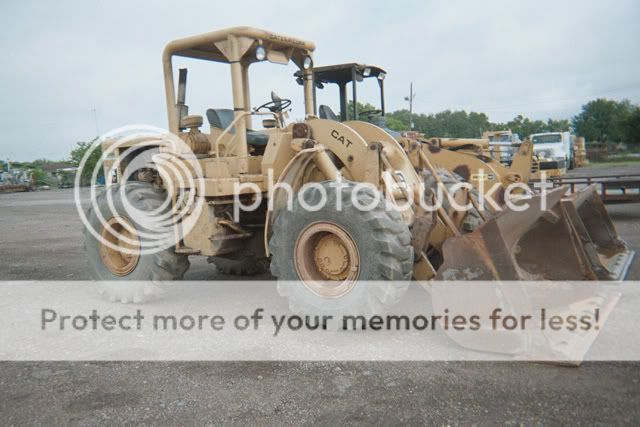
The next oldest Cat had a flimsy canopy like the one you can see on the loader in the rear. It was good for keeping the rain and the sun off you when you were working outside, which was pretty rare. This Cat was broken in perfectly and my favorite.
Caterpillar 950
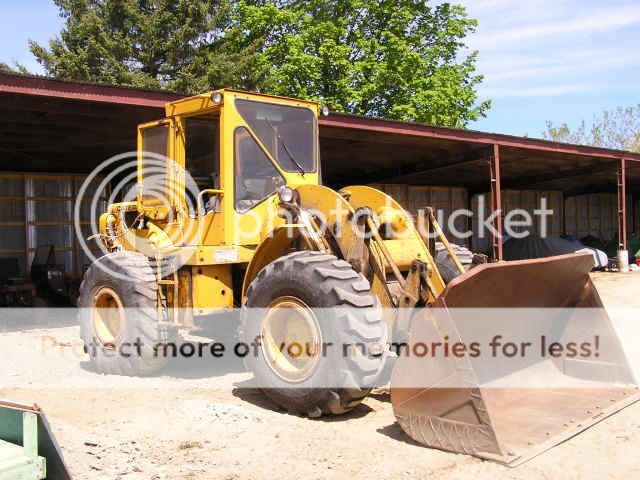
We finally got one of these and at first only the senior operator was allowed to enter its hallowed cab, but not much later, it was just one of the Cats. It was extremely tight and the cab, while keeping you clean in an incredibly dusty environment, isolated you from the operation so much, you felt like you were in a space capsule. That didn't matter much, because the only cooling device it had was a small fan that broke in the first week because of the dust, so everyone operated it with the doors open, but it was still uncomfortably hot in the cab, so no one really wanted to operate it anyway. The feed when it came from the refinery was several hindered degrees, so warehouses were hot as hell in the summer and could be quite toasty in the winter.
Michigan loader
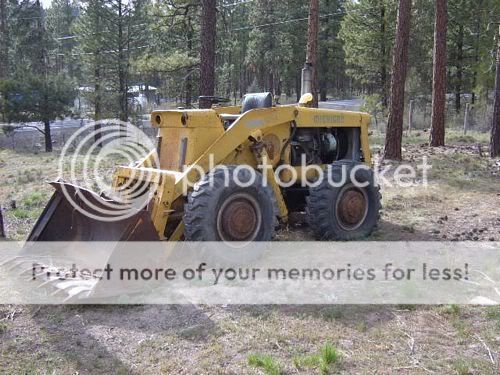
If this picture isn't of the very same model we had, it is very, very close. This was a large, lumbering beast that was slow, highly difficult to maneuver and felt like it was in constant danger of tipping over.
New operators were relegated to the "Big Michigan," as it was called and the day they graduated to a Cat was a day of great jubilation. There is nothing good I can say about this monstrosity, except that it was actually easier to operate than the "Little Michigan" we used for cleanup in close quarters.
TrackMobile
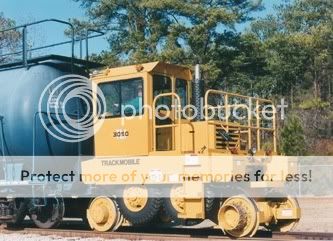
This picture shows a TrackMobile that is very close to the one we had on the dock, but ours was in such bad condition, it was next to useless. It was better to ride the rail cars down by gravity, if you could get them to start moving with one of the Cats, but very often the trackmobile was the only way and the officially prescribed way to move the cars into position to load. In other words, don't get caught moving the cars by gravity while riding the brakes, unless you were taking the cars from the loading stations to the staging area.
Our machine was so bad that the only way to get it onto the track was to go backward while straddling the track and then lower it onto the track while using the steering wheel to control the twist so that you could get the little wheels on the tracks. If you tried this standing still, you might be out there for eight hours trying to get the thing on the tracks. The moving method took time to master, but it was surefire after that. Let's not talk about how the thing operated on wet or icy track. That was often a hellish nightmare.
The one thing that was fun about the trackmobile was if you were traveling in the right direction relative to a switch, you could throw the switch without having to get down and do it manually by getting the machine going about as fast as it would go and slamming on the brakes making it slide through the switch, thus throwing it "automatically." Fun on a potash mine loading dock was often of a perverse nature.
Add these duties to operating the bulk-loading stations and stacking the 100 lb. bags in the box cars and the loading dock made for a very interesting and fun place to work. The chance of injury on the dock was pretty high, but when I worked there, there had only been one man killed on the dock in the history of the mine. I experienced and observed many close calls while there, but fortunately there were no serious injuries.
If I had kept that job, I would have lived a very normal life. I decided to take a different, less secure path that has led me to where I am now. I'm not better off financially, but the trip has been about as unlikely a story as you're ever likely to hear.
I won't bore you with that now.
[edit on 2008/8/18 by GradyPhilpott]
Well, I did a little research last night before I finally got so sleepy I couldn't stay up any longer.
As I said, my heavy equipment days are long behind me, but I did find pictures on the internet of machines that are very close to the ones I operated as a potash mine loading dock operator in Carlsbad, New Mexico in the mid-seventies.
Caterpillar 950

The oldest of the Cats was like this, completely open and by the time I went work there, it was as loose as a goose, but still fun to operate. Depending on the warehouse we worked in with these, the pace was slow and the space cramped with the hopper openings about ten feet above the ground to much larger warehouses where, even if the place was so full it was cramped, you could with some diligent work clear enough space to make the job as fun as anything you can imagine.
In the larger warehouses, the hoppers were buried in the floor, so that you could just push the potash into the hopper when the warehouse was full or race like hell to carry the potash in your four-ton capacity bucket to the hopper where the belt was running at six tons a minute.
It was under the latter conditions that was the most fun. The Cat 950 was in those days the Formula One equivalent of front-end loaders. They were powerful and fast, with a gear shift and direction lever on the left-hand side of the steering wheel. To go forward you pushed the lever forward and shifted through the four gears by twisting the lever. To go backward, you pulled the lever back and twisted the lever to go through four gears. Four reverse gears can make things pretty exciting at times.
The only way you could get a break was to build a pile on the hopper grate high enough to let you go smoke a cigarette or go to the head. It was during this time that I began to dip.
In the warehouses with raised hoppers, you were pretty much stuck, because once the hopper was full there was no more adding to it and they would empty pretty fast, so the pace was slow and steady, which could make for a pretty mind-numbing shift.
The Cats were also articulated which meant that they bent in the middle, which made them highly maneuverable. Whichever warehouse you were working in, you better hope you were working with one of the Cat 950's, because if you had the old Michigan loader with the turning rear wheels, you were in for a a very rough shift. Loaders were assigned by seniority.
Caterpillar 950

The next oldest Cat had a flimsy canopy like the one you can see on the loader in the rear. It was good for keeping the rain and the sun off you when you were working outside, which was pretty rare. This Cat was broken in perfectly and my favorite.
Caterpillar 950

We finally got one of these and at first only the senior operator was allowed to enter its hallowed cab, but not much later, it was just one of the Cats. It was extremely tight and the cab, while keeping you clean in an incredibly dusty environment, isolated you from the operation so much, you felt like you were in a space capsule. That didn't matter much, because the only cooling device it had was a small fan that broke in the first week because of the dust, so everyone operated it with the doors open, but it was still uncomfortably hot in the cab, so no one really wanted to operate it anyway. The feed when it came from the refinery was several hindered degrees, so warehouses were hot as hell in the summer and could be quite toasty in the winter.
Michigan loader

If this picture isn't of the very same model we had, it is very, very close. This was a large, lumbering beast that was slow, highly difficult to maneuver and felt like it was in constant danger of tipping over.
New operators were relegated to the "Big Michigan," as it was called and the day they graduated to a Cat was a day of great jubilation. There is nothing good I can say about this monstrosity, except that it was actually easier to operate than the "Little Michigan" we used for cleanup in close quarters.
TrackMobile

This picture shows a TrackMobile that is very close to the one we had on the dock, but ours was in such bad condition, it was next to useless. It was better to ride the rail cars down by gravity, if you could get them to start moving with one of the Cats, but very often the trackmobile was the only way and the officially prescribed way to move the cars into position to load. In other words, don't get caught moving the cars by gravity while riding the brakes, unless you were taking the cars from the loading stations to the staging area.
Our machine was so bad that the only way to get it onto the track was to go backward while straddling the track and then lower it onto the track while using the steering wheel to control the twist so that you could get the little wheels on the tracks. If you tried this standing still, you might be out there for eight hours trying to get the thing on the tracks. The moving method took time to master, but it was surefire after that. Let's not talk about how the thing operated on wet or icy track. That was often a hellish nightmare.
The one thing that was fun about the trackmobile was if you were traveling in the right direction relative to a switch, you could throw the switch without having to get down and do it manually by getting the machine going about as fast as it would go and slamming on the brakes making it slide through the switch, thus throwing it "automatically." Fun on a potash mine loading dock was often of a perverse nature.
Add these duties to operating the bulk-loading stations and stacking the 100 lb. bags in the box cars and the loading dock made for a very interesting and fun place to work. The chance of injury on the dock was pretty high, but when I worked there, there had only been one man killed on the dock in the history of the mine. I experienced and observed many close calls while there, but fortunately there were no serious injuries.
If I had kept that job, I would have lived a very normal life. I decided to take a different, less secure path that has led me to where I am now. I'm not better off financially, but the trip has been about as unlikely a story as you're ever likely to hear.
I won't bore you with that now.
[edit on 2008/8/18 by GradyPhilpott]
Fascinating thread. The Grappler is truly a marvel. The operator is phenomenal. He uses that "Arm" like an extension of his body. Amazing.
Back in the early 80's, I operated forklifts and warehouse ponies at the DLA Warehouse in West Germany. It had to be the most fun job of my life. We drove electric as well as internal combustion models. The best, in my opinion was the internal combustion motor models. They were faster, easier to handle, and by far the most fun. We often had races in the parking lot. I never participated as a driver, but I think I was the most spirited spectator. I loved it. Of course, it was against every protocol there was, but it was great fun, and made more fun by being forbidden.
great memories!!!!!!
Back in the early 80's, I operated forklifts and warehouse ponies at the DLA Warehouse in West Germany. It had to be the most fun job of my life. We drove electric as well as internal combustion models. The best, in my opinion was the internal combustion motor models. They were faster, easier to handle, and by far the most fun. We often had races in the parking lot. I never participated as a driver, but I think I was the most spirited spectator. I loved it. Of course, it was against every protocol there was, but it was great fun, and made more fun by being forbidden.
great memories!!!!!!
Cool vid! Northern New Mexico is a very beautiful area, a good friend of mine has a house up in Angel Fire and I always love the drive up there.
I was a grading foreman starting out worked for a small company so in case of no show I would have to jump on iron as well as do my other job,once you
get used to it,lot's of fun,suprisingly easy to be able to cut to grade as well,thing I hated was the grease if you got any on you had to throw
clothes away,but I was almost killed when a 657 came bearing down on me with a full load,had to jump off 22ft stockpile to concrete
new topics
-
Of course it was DEI
Dissecting Disinformation: 8 hours ago -
2nd Day Thanksgiving!...(leftovers!!)
General Chit Chat: 10 hours ago
top topics
-
Of course it was DEI
Dissecting Disinformation: 8 hours ago, 6 flags -
2nd Day Thanksgiving!...(leftovers!!)
General Chit Chat: 10 hours ago, 3 flags
3
